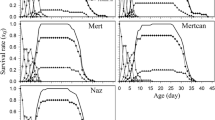Abstract
Development, survival, reproduction rate, and population growth parameters of the mealy plum aphidHyalopterus pruni (Geoffroy) (Hom.: Aphididae) were evaluated on four different apricot cultivars (Tyrinte, Sakıt, Colomer, and Bebeco) under field conditions in the Van region of Turkey. Experiments were carried out on exterior leaves of trees, 1.5–2 m above the ground. Plexiglas clip-cells (25×6 mm) with the upper side covered by muslin were used in the experiments. The mealy plum aphid performed better on Tyrinte than on the other cultivars tested. The fastest development time (first instar to adult; 9.4 days), highest daily reproduction rate (2.6 offspring/aphid/day), and highest total fecundity (48.1 offspring/aphid) were obtained on Tyrinte. The intrinsic rate of increase — a good indicator of the growth potential of a population — of individuals fed on Tyrinte was significantly greater than that of individuals fed on cvs. Colomer and Bebeco. While mean generation times (T o ) of populations on different cultivars were close to each other, the net reproductive rate was the highest (29.45 offspring/aphid/generation) on Tyrinte and the population doubling time on Tyrinte was 18.7%, 25.2% and 26.3% faster than those of individuals on other cultivars tested. The results obtained in this study indicated that Tyrinte appeared to be the most susceptible to the mealy plum aphid among the cultivars tested.
Similar content being viewed by others

References
Andrewartha, H.G. and Birch, L.C. (1970) The Distribution and Abundance of Animals. Univ. of Chicago Press, Chicago, IL, USA.
Atlıhan, R., Denizhan, E. and Yaşar, B. (1999) Effects of different preys on development and fecundity ofScymnus subvillosus Goeze (Coleoptera: Coccinellidae).Proc. IV Turkish National Congress of Biological Control (Adana, Turkey), pp. 397–406 (Turkish, with English summary).
Blackman, R.L. and Eastop, V.F. (1984) Aphids on the World’s Crops: An Identification and Information Guide. John Wiley & Sons, Chichester, UK.
Bodenheimer, F.S. and Swirski, E. (1957) The Aphidoidea of the Middle East. The Weizmann Science Press of Israel, Jerusalem, Israel.
Chambliss, O.L. and Jones, C.M. (1966) Chemical and genetic basis for insect resistance in cucurbits.J. Am. Soc. Hortic. Sci. 59:394–405.
Da Costa, C.P. and Jones, C.M. (1971) Resistance in cucumber,Cucumis sativus L., to three species of cucumber beetles.HortScience 6:340–342.
Ellis, P.R. and Farrel, J.A. (1995) Resistance to cabbage aphid (Brevicoryne brassicae) in six brassica accessions in New Zealand.N.Z. J. Crop Hortic. Sci. 23:25–29.
Howe, W.L., Sanborn, J.R. and Rhodes, A.M. (1976) Western corn rootworm adult and spotted cucumber beetle associations with cucurbitacins.Environ. Entomol. 5:1043–1048.
Kazemi, M.H., Talebi-Chaichi, P., Shakiba, M.R. and Mashhadi Jafarloo, M. (2001) Responses of Russian Wheat Aphid,Diuraphis noxia (Mordvilko) (Homoptera: Aphididae), to different wheat varieties.J. Agric. Sci. Technol. 3:249–255.
Kennedy, G.G. and Abou-Ghadir, M.F. (1979) Bionomics of the turnip aphid on two turnip cultivars.J. Econ. Entomol. 72:754–757.
Kooistra, E. (1971) Red spider mite tolerance in cucumber.Euphytica 20:47–50.
Meyer, J.S., Ingersoll, C.G., McDonald, L.L. and Boyce, M.S. (1986) Estimating uncertainty in population growth rates: Jackknife vs. bootstrap techniques.Ecology 67:1156–1166.
Miniou, N. (1973) The vectors transmitting plum pox virus (Prunus virus 7 Christ.) to plum.An. Inst. Cercet. Prot. Plant. 9:49–56.
SAS (1998) User’s Manual. version 7.0. SAS Institute, Cary, NC, USA.
Satar, S. and Raymond, Y. (2002) Effect of temperature and host on development ofBrachycaudus schwartzi (Homoptera: Aphididae).Ann. Entomol. Soc. Am. 95:597–602.
Sokal, R.R. and Rohlf, F.J. (1981) Biometry. 2nd ed. Freeman, New York, NY.
Tang, Y. Q., Lapointe, S. L., Brown, L. G. and Hunter, W. B. (1999) Effects of host plant and temperature on the biology ofToxoptera citricida (Homoptera: Aphididae).Environ. Entomol. 5:895–900.
Toros, S. (1974) Research on the Morphology, Biology, Host Plants and Control of Hawthorn Spider Mite,Tetranychus vienensis Zacher (Acarina: Tetranychidae), in the Region of the Middle Anatolia. Publ. No. 514. Agriculture Faculty, Ankara University, Ankara, Turkey (Turkish, with English summary).
Toros, S., Yaşar, B., Özgökçe, M.S. and Kasap, I. (1996) Studies on determination of Aphidoidea species in Van province.Proc. IV Turkish National Entomological Congress (Ankara, Turkey), pp. 549–556 (Turkish, with English summary).
Tsai, J.H. (1998) Development, survivorship and reproduction ofToxoptera citricida (Kirkaldy) (Homoptera: Aphididae) on eight host plants.Environ. Entomol. 27:1190–1195.
van de Vrie, M., McMurtry, J.A. and Huffaker, C.B. (1972) Ecology of tetranychid mites and their natural enemies: A review. III. Biology, ecology and pest status and host plant relations of tetranychids.Hilgardia 41:343–432.
Author information
Authors and Affiliations
Corresponding author
Additional information
http://www.phytoparasitica.org. posting Nov. 23, 2004.
Rights and permissions
About this article
Cite this article
Özgökçe, M.S., Atlıhan, R. Biological features and life table parameters of the mealy plum aphidHyalopterus pruni on different apricot cultivars. Phytoparasitica 33, 7–14 (2005). https://doi.org/10.1007/BF02980919
Issue Date:
DOI: https://doi.org/10.1007/BF02980919



